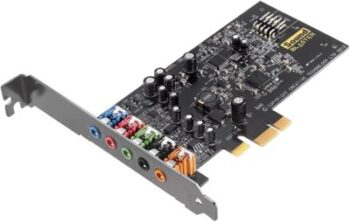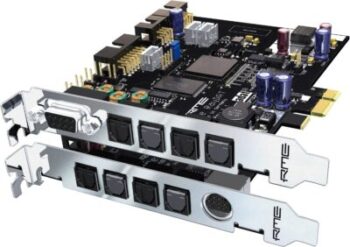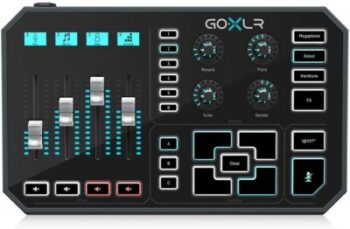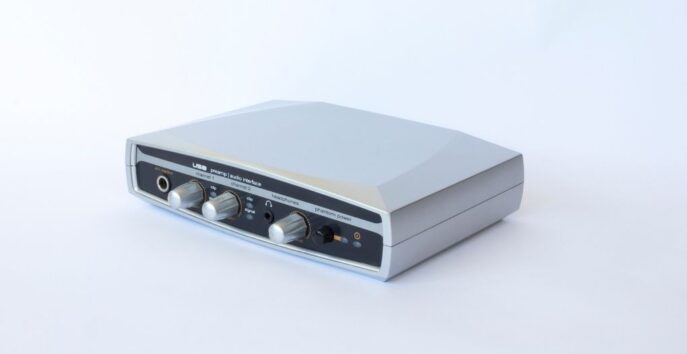Whether you are a professional or a hobbyist, the PC sound card will do you proud. Connected via USB or PCI-E bus, this computer peripheral allows you to record the signal from your instruments with superior audio quality. To help you find the best PC sound card, we've put together this guide with buying tips and top products of the moment.
Here is our commitment, to make sure that we provide the best user experience and content quality:
You can support us by using our links to make your purchases (at no extra cost to you)! This sometimes earns us a commission which allows us to remain independent. More about us
Our selection
"The Scarlett Solo 3Rd Gen is a professional level sound card perfect for singers or songwriters. In addition, it features the famous Focusrite preamp and…"
"The Creative Sound Blaster Audigy is a perfect upgrade to your built-in sound card. Using SBX Pro Studio technology, it can deliver high-quality 5.1 sound…"
"The RME HDSPe RayDAT is a professional quality, multi-channel, multi-format, multi-tasking PCi-Ex sound card for your home studio."
"Podcaster or Streamer, this is your PC sound card. It is a mixer with effects and a sampling device for live broadcasters. It's an all-in-one…"

The Scarlett Solo 3Rd Gen is a professional level sound card perfect for singers or songwriters. In addition, it features the famous Focusrite preamp and has intuitive controls.
See the priceCompact, yet professional, the Focusrite Scarlett Solo 3rd Gen sound card features input channels including XLR and Hi-Z connections, allowing you to connect any microphone or electronic musical instrument. In addition, it has Focusrite's most powerful preamplifier. The sound resolution is very high, with a 24-bit analog-to-digital signal conversion function with a 192 kHz sampling rate, professional quality.
Functional, it comes with +48V phantom power for your condenser microphones. On the front panel, you have two Gain controls with Halo that glows green when levels are good. The Direct Monitor button lets you hear what you're playing and recording. For speakers, it has two balanced TRS speaker outputs on the back. Finally, it comes with a USB cable and a range of software like Ableton Live Lite or Pro Tools First.

The Creative Sound Blaster Audigy is a perfect upgrade to your built-in sound card. Using SBX Pro Studio technology, it can deliver high-quality 5.1 sound effects for your movies, music and games.
See the priceThe Sound Blaster Audigy Fx is a PCi Express, x1 sound card based on SBX Pro Studio technology. It will turn your PC into a 5.1 multimedia center that offers cinematic surround sound perfect for bringing out the best in your multimedia files. The sound quality will surprise you as it features a 24-bit DAC with 192kHz (playback), 106dB SNR and a high-quality 600-ohm headphone amplifier for studio-quality listening.
Versatile, the Audigy FX is Win 10 compatible, driver downloadable, and comes with Creative Software Suite, Creative Diagnostics, Creative ALchemy. Installation is quick, as Creative includes an extra-flat mounting bracket.

The RME HDSPe RayDAT is a professional quality, multi-channel, multi-format, multi-tasking PCi-Ex sound card for your home studio.
See the priceIf you are looking for a professional solution for your recordings up to the final mastering, the RME HDSPe RayDAT will more than convince you. Compatible with Windows and Mac OS, it features a 24-bit converter with 192 kHz sampling. Equipped with a PCi Express bus, your recordings will not suffer from latency.
The SPDIF and AES/EBU (XLR) interfaces work simultaneously thanks to the division of the hardware and the separate playback/recording function. This professional device offers a total of 36 input and output channels including 4 ADAT I/O. In addition, you have 2 interfaces, I/O, MIDI, RME's real-time DSP mixer/router, with calculated level measurement.

Podcaster or Streamer, this is your PC sound card. It is a mixer with effects and a sampling device for live broadcasters. It's an all-in-one solution!
See the priceThe Go XLR puts you in control of your audio with a 4-channel (2×2) digital stereo mixer for real-time volume control of all your audio sources, customizable motorized faders, and an LED level display. The converter has a 24-bit resolution with a 48 kHz AN/NA sampling rate. It features sampling, importing and recording, and is equipped with various vocal effects: Reverb, Delay, Pitch, Genre, Megaphone, Robot, Hardtune.
As an interface, the XLR Go offers a microphone input, 3.5 mm mini-jack, and +48v phantom power. Then you have a stereo line I/O interface, a headphone output and an optical S/PDIF input.
Any specific needs?
The best entry-level PC sound card
The best PC sound card for streaming
Your guide :
Rate this buying guide :By rating this buying guide, you are helping us to reward our best writers. Thank you!
| TOP OF THE LINE | CHEAP | TOP OF THE LINE | VERY GOOD | |

In accordance with our commitment, this buying guide does not contain any sponsored products. |
 8/10 |
 8/10 |
 9/10 |
 9/10 |
| OUR SELECTION |
Focusrite Scarlett Solo 3rd Gen
|
Creative Sound Blaster Audigy Fx
|
RME HDSPe RayDAT
|
TC-Helicon GO XLR
|
|
The Scarlett Solo 3Rd Gen is a professional level sound card perfect for singers or songwriters. In addition, it features the famous Focusrite preamp and has intuitive controls.
|
The Creative Sound Blaster Audigy is a perfect upgrade to your built-in sound card. Using SBX Pro Studio technology, it can deliver high-quality 5.1 sound effects for your movies, music and games.
|
The RME HDSPe RayDAT is a professional quality, multi-channel, multi-format, multi-tasking PCi-Ex sound card for your home studio.
|
Podcaster or Streamer, this is your PC sound card. It is a mixer with effects and a sampling device for live broadcasters. It's an all-in-one solution!
|
|
|
|
Good sound quality
|
Quick setup
|
Up to 36 I/O channels
|
Various vocal effects
|
|
|
Easy to install
|
5.1 surround sound
|
8 buffer sizes
|
Mute button
|
|
|
Intuitive controls
|
Can power high-impedance headphones
|
Simultaneously operational I/O
|
Go XLR application
|
Help us improve this table:
Report an error, request the addition of a feature to the table, or suggest another product. Thank you for your kindness!
We spend thousands of hours each year studying the major specialized websites, analyzing products of hundreds of brands and reading user feedback to advise you on the best products.
We are a product review company with a single mission: to simplify your buying decisions. Our research and testing helps millions of people every year find the best products for their personal needs and budget.
To support us you can: use our links to make your purchases (which often earns us a small commission), share our articles on social networks, or recommend our site on your blog. Thanks in advance for your support!
Choosing the best PC sound card will depend on your needs and the type of audio editing you want to do. If you're a mobile musician, it's a good idea to choose a USB model and an internal, PCI card for a home studio. But that's not the whole story on PC sound cards. Here are some basic criteria to keep in mind when making your purchase.

The sound performance of a PC sound card will depend on two things: resolution and sampling.
the uninitiated, it is expressed in Bits and the higher this value is, the better the sound rendering will be. Most of the sound cards integrated, or audio chipsets, on a motherboard currently offer a resolution of 16 Bits. For this reason we advise you to choose a model with at least 24 Bits. This is the perfect mix between professional and multimedia use.
we keep the same principle as the sound resolution. A high value is a sign of better performance. Also called Sampling, the standard is currently CD quality which is 44.1 kHz. The reason is that this sampling rate broadcasts an audio frequency of 22 kHz which is the limit of the human ear. Beyond that, it will be difficult for the uninitiated to distinguish differences. A studio will use a sampling between 96 and 192 kHz.
To improve the final rendering, it is recommended to increase the resolution from 16 to 24 Bits or from 24 Bits to 32 Bits.
This
is the most important criteria on a PC sound card. Clearly, you must have the inputs and outputs corresponding to your audio equipment and instruments. You can see different types of connectors depending on the range of PC audio cards you want to acquire. The more professional models will be able to have XLR inputs for the more Pro microphones, 6.35mm jack inputs and outputs for your instruments, and headphones, monitor outputs and MIDI connectors, for example.
In
a nutshell, that's the maximum volume your PC sound card will be able to deliver before the sound output degrades or saturates. High-end models have a signal-to-noise ratio that can exceed 120 dB. For more moderate use, cards with an SNR between 106 and 116 dB will be more than sufficient.
For
example, on a dual-output stereo PC sound card you will only be able to connect two pairs of speakers. Here, it is therefore essential that you know what type of audio setup you want to put in place. For greater flexibility of use, it is recommended to start with a 5.1 multichannel model, at least.
In addition, it will be ideal to have encoding standards such as Dolby, THX and surround sound to emulate 3D sound. Which is perfect when you are watching movies or playing games.
On the
market, you can have PC sound cards manufactured for a few years still put on sale. You have to be careful! Indeed, the big brands accompany their products for years by regularly updating their drivers while others don't. This is a concern since your new acquisition might not be compatible with Win 10 for example.
To avoid this, take the name of the product and check on the official website of the manufacturer the different drivers offered and their compatibility. Moreover, you should know that not all PC sound cards are universal: Windows and Mac. It is therefore important before your purchase to look carefully at the operating systems supported by the product.
This
part mainly concerns external PC sound cards connecting via USB or Thunderbolt, for example. The operation of the adjustment buttons on the surface of the case will have to be intuitive. It will be a failed purchase if you have to spend 10 times more time trying to figure out how the PC sound card works than actually using it. For this reason, you are advised to read the user manual well before your purchase. You can find it on the manufacturer's website or on some online sales sites.
Unlike USB PC sound cards, which can be plugged in quickly, PCI models must be installed inside your computer case. The first step will be to see which type of PCI slot is compatible with your model. The PCI-E1 (1x) has two small tabs while the PCI-E (3) has a larger tab on the front and a smaller one on the back. The large bus is the PCI-Express (16x) normally dedicated to graphics cards.
Secondly, you will open the side panel of your tower by unscrewing the screws on the back or directly on the panel. Also, don't forget to unscrew the screw cover at the bottom of the case. Once open, look at the slot for the port that concerns you. To install your PC sound card, you must hold the card firmly and push it into the slot. Once it is in place, screw the card's mounting mechanism firmly into the slot on your case.
Once you've closed everything, it's time to boot up your PC and install the supplied driver. For optimal performance, it is recommended to download an updated version of the driver. This also applies to USB models.
USB models, especially low-end ones, have a latency. Specifically, when you press a note from a keyboard, the sound will have a delay. This can be quickly frustrating especially when setting up a recording studio. The PCI card is 100% reliable since it is connected directly to the motherboard, but the settings will be done digitally via software. On a USB model, your hands will be in contact with the different buttons.
When we talk about an integrated sound card, we are referring to the audio chipset that is soldered to the motherboard like the Realtek brand. The sound definition of these cards varies depending on the quality of the motherboard you have. If you have a high-end motherboard, you will have better sound. The main advantage is that you don't have to buy an external card.
The external model can come in two forms: USB or internal. The internal type will connect to your motherboard's ISA, PCI or PCI-Express expansion bus. They have the particularity of being more powerful than the USB models, at the same price, but with compromises on functionality. In addition, PCI models require more effort to install. In short, the cards offer more performance than their embedded counterparts. However, they come at a cost.
With the technological advances made on integrated sound cards, these are more than enough for multimedia or gaming use. People looking for more performance, such as music professionals or novice deejays, must turn to more advanced solutions such as external cards. However, we advise against buying an entry-level sound card, under 50 euros, if you have a modern motherboard, as the difference will not be audible.
Better speakers
It will be pointless to buy a PC sound card if you plan to use it with PC speakers. The sound quality of your brand new hardware will seem equivalent to the motherboard chipset. To see a difference, it is recommended to have better speakers that can reproduce the prowess of your sound card.
Close your applications
If you run different applications at the same time as you record a song, it will affect the quality of the song. It will be wise to close all non-useful applications and just run the music software.
Use better cables
Standard power cables emit distortion that can harm your recordings. As in a studio level audio setup, consider using high-end cables.
Use quality audio software
In order not to lose your inspirations on your guitar or synthesizer, consider using a high-end recording software. That way, your songs will sound better.
Invest in good headphones
Buying headphones suitable for a recording studio will increase your productivity. It will reproduce sounds more faithfully unlike a PC headset.
The best PC sound card depends on your needs and your budget. Read our buying guide to find out which products are the best.
Yes. But you should know that PC and laptop sound cards are not the same. You have to buy a laptop model. The other difference is the installation which will be more difficult. If you don't feel brave enough to handle your laptop, we advise you to call a specialist.
If you want to have better sound when playing online or if you want to set up a small recording studio, the built-in card on your motherboard won't be of much help. A PC sound card will improve the quality of your sound and it has multiple functions for spatialization for example.
The interesting feature for gaming is the Dolby Surround and the ability of the sound card to simulate a 3D sound environment. In this sense, it is better to choose a 5.1 model.
Yes, but you will have a lot of distortion in your recording. A more effective solution would be to use a hands-free kit for Smartphone.
Every month we help more than 1 000 000 people buy better and smarter.
Copyright © 2022 - Made with ♥ by buyingbetter.co.uk
Your reviews and buying guides 0% advertising, 100% independent!